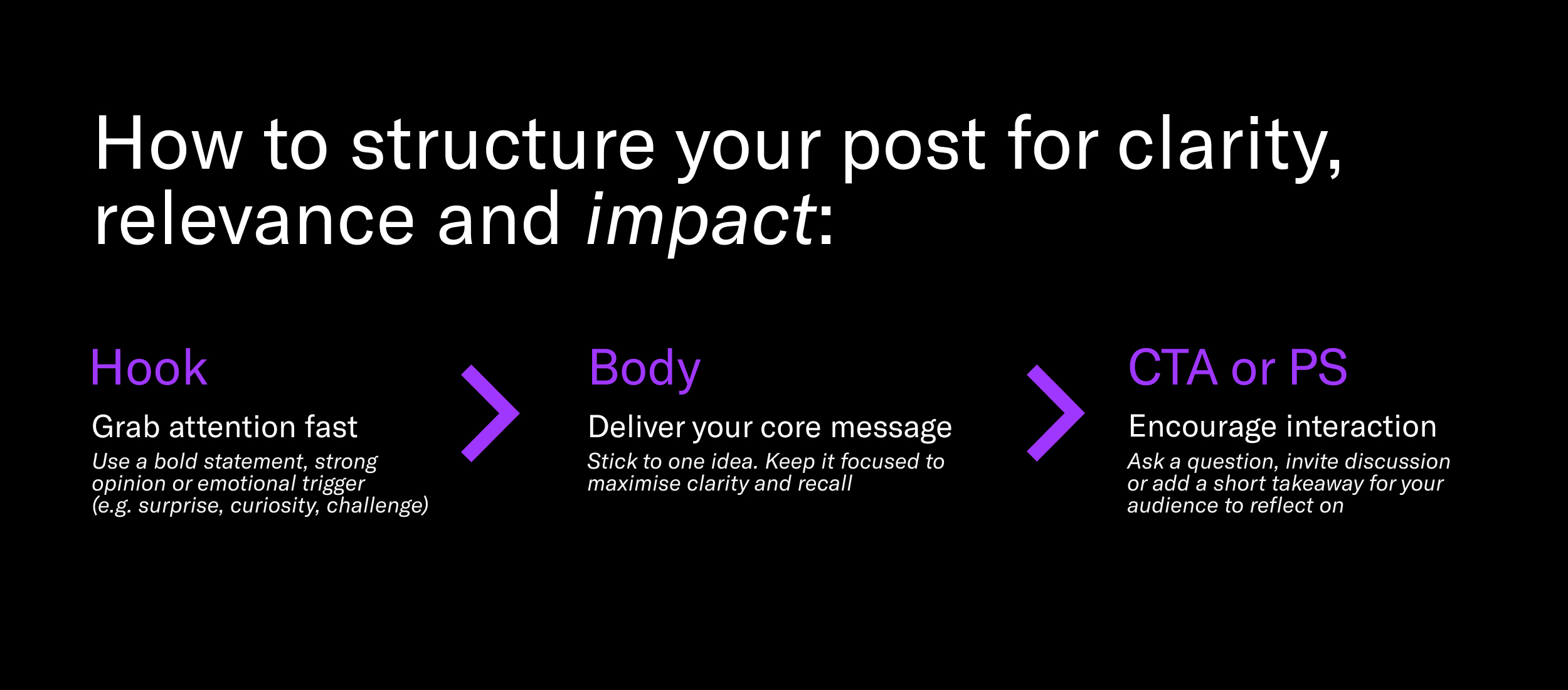Organic LinkedIn content still holds value — but only when it’s done with purpose.
Plenty of B2B brands post regularly but their content doesn’t always connect. It might open too slowly, try to cover too much or lean too heavily on corporate language. And in sectors where messaging is technical and nuanced — and often needs to resonate with multiple decision-makers — that’s a missed opportunity.
For many marketers, the challenge isn’t what to say. It’s how to say it in a way that feels clear, relevant and worth engaging with.
This isn’t about chasing trends or playing the algorithm. It’s about getting the fundamentals right. In this blog, I’ve pulled together a few practical ways to make your B2B LinkedIn strategy and organic content work harder.
Start with a strong hook
Most people scroll quickly on LinkedIn and mobile users only see the first 100–150 characters of a post before it’s cut off. That’s why your opening line matters a lot.
Start with something that draws people in: a bold statement, a clear opinion or a simple question. Then move into your main message and wrap up with a call to action (CTA) or a brief postscript (PS).
The following content structure for LinkedIn helps readers follow your message and improves engagement: Hook → Body → CTA or PS

Keep the focus tight. A single, well-developed message is more effective than trying to cover multiple points in one go — which can dilute impact and make the post harder to absorb.
Keep the language clear and natural
In B2B, especially when your product or service is technical, it’s easy to default to corporate or overly formal or complex language. But on LinkedIn, clarity and relatability tend to perform better than polish.
That doesn’t mean being overly casual. It means writing the way your audience thinks and speaks.
Use short sentences. Break up longer blocks of text with line spacing. And if it suits your tone, emojis can help highlight key points — just use them sparingly.
One more thing to note: posts without links perform better. LinkedIn deprioritises content that drives users off-platform. If you do need to share a link, consider adding it in the comments instead — and focus on delivering standalone value in the post itself.
Prioritise storytelling
In B2B, we often focus on features, benefits, data and proof points. But storytelling can be just as powerful — especially when you’re trying to build trust over time.
Real stories help your audience relate to what you do. They give context, credibility and a human edge — and they don’t need to be long to be effective.
Think about:
- A customer challenge you helped solve
- A behind-the-scenes moment from your team
- A common misconception in your sector and your take on it
Avoid overly stylised stock images or vague, generic marketing claims. Instead, focus on communicating authentic moments that show real people, processes and perspectives.
Use emotion to drive relevance
Emotion has a place in B2B, especially when it reflects something your audience genuinely cares about. Curiosity, frustration or surprise can help make a post more memorable and more engaging.
That doesn’t mean switching to clickbait tactics. It’s about understanding your audience’s pain points, misconceptions or day-to-day realities and responding with content that reflects them.
Formats that work well include:
1. Myth-busting
Addressing common misunderstandings in your industry
2. Provocative perspectives
Offering a thoughtful take that challenges the status quo
3. Shared experiences
Highlighting familiar moments your audience will relate to
These posts tend to spark discussion and help your brand feel more confident, relevant and real.
Use video to build trust (not just attention)
There’s a lot of focus on short-form video and while brevity has its place, longer videos can work just as well on LinkedIn. The key isn’t the length. It’s the value.
If your video gives your audience something useful — a new way of thinking, a practical tip, or insight they can apply — they’ll stick with it. What matters most is whether the content feels worth their time.
That’s where structure comes in. A clear, purposeful format helps you deliver value and hold attention from start to finish. A good example is:
- Hook (0–3 seconds) – Grab attention with a question, bold statement or common challenge
- Setup (3–10 seconds) – Briefly explain why the topic matters or who it’s for
- Main content – Share your insight: a quick explainer, case study
,or expert view
- Optional CTA – Invite comments, questions or further discussion
Keep the visuals simple. You don’t need high production but rather a steady message, a clear voice and something your audience will gain from watching.
Final thoughts
B2B organic content goes beyond chasing big numbers. It’s about showing up consistently with something that’s clear, relevant and useful so your audience keeps you top of mind.
For B2B marketers working in complex or technical spaces, the opportunity isn’t just to post more often. It’s to post with more intent.
A strong hook. A clear message. Language that feels natural. And ideas worth engaging with. That’s what makes content land — and what helps LinkedIn work harder organically for your brand.

